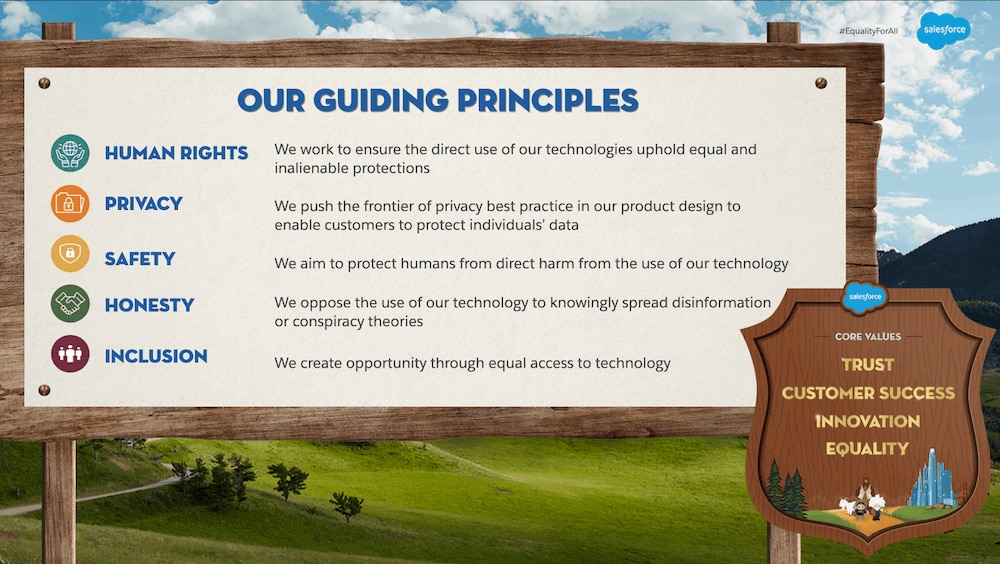Today’s growing technology has brought a concern about how new and disruptive technologies like artificial intelligence (AI), internet of things (IoT), robotics, quantum computing, biotechnology etc should be handled and governed the right way. Businesses today are well aware of the fact that the technology they create can have a huge ethical outcome. Since technology is vast and complex, at the time of measuring the potential influence of what the businesses are developing in terms of products and services, they usually get confused where to start from. Therefore, in this article we will unfold the solutions to maintain a responsible tech in the midst of hostile tech.

A broader perspective on tech hostility
The term hostile tech can encompass not only something illegal or criminal tech like malware and hacking tools, but even cases such as advertising and customer targeting. Every individual has a different perception regarding the fact that a technology is either hostile or not. Let’s say some people find internet advertising, tracking cookies or social media influencing campaigns very normal, not hostile at all. They would rather like to trade their data since that helps them in gaining personalized offers or special value. But at the same time, others are seen installing ad blocking software in their browsers and entirely abandoning Facebook.
Hostile tech can sometimes be totally unintentional. For instance, people didn’t wantedly, build an image recognition software that would deliver inconsistent results while recognizing the faces of black women. It wasn’t built with any kind of bias, the only problem was, the poor data set. Let me share one more example, i.e. bias in algorithms or machine learning systems. These might express hostile tendencies towards some specific customer groups unintentionally. For better understanding, here are some signals of such shift which also includes:
- The ubiquity of technology has been increasing, along with that increases the technology threats. Due to the huge number of connections, IDC believes that the number of active Internet of Things devices will certainly grow to 55.7 billion by 2025. There is a possibility that each of these might come along with security breaches which could be exploited.
- Increase in anxiety regarding the use and influence of social media in political campaigns, and the manner in which political and other societal debates are being shaped up the social media channels.
- Due to an increase in the use of AI and machine learning, consequences like bias in algorithms can be seen.
The right time to adopt an ethical tech approach
From the very beginning, the organizations should adopt an ethical tech approach towards the emerging technologies and innovation. It has to be a combination of both ethics‑based and human‑rights‑based approaches in order to maintain the responsible use of technology. Human-rights based approach is very significant since it facilitates a universal foundation upon which numerous ethical frameworks, options and judgments can be applied. Basically, the ethics-based approach looks after a wide perspective on matters in regard to right and wrong, also including the perspectives of various cultures, traditions and religions. Ethical tech is well adopted by a broad range of stakeholders from government, business, academic community, and civil society in the context of various disruptive technologies with the capability for widespread societal influence, like artificial intelligence, robotics and biotechnology. With this approach you can plan about how responsibly technologies can be developed, deployed and used in the right order. Also, technology innovation can be well supported by responsible technology.
It is observed that extensively ethic-based approaches focus on artificial intelligence. Around 25 countries have already announced national AI strategies, ethical tasks are being established around the world, and also institutes and associations starting from the European Commission to the Association for Computer Machinery and the Institute for Electrical and Electronics Engineers have publicized ethical instructions and guidelines for AI or even autonomous systems.
Some of the leading technology companies like Google, Microsoft, Salesforce, IBM, NEC and Cisco have established their ethical principles and positions, operationalizing and integrating them into their work and business. The companies have started addressing some of the significant questions like what is to be sold, what are the best practices and guidance that need to be promoted, and in what ways you can build the different notions of fairness and distributive justice into algorithms. To know more, read these comprehensive guides on ethical technology and ethical design.
You can go through Salesforce initiatives in building a culture of responsible technology here.

A closer look at responsible tech
Why do we need to be responsible in technology? Responsible tech helps in aligning technology and business behavior with an individual as well as the society’s interest. It considers the values, unintended circumstances and negative influence of tech and reduces the risk and harm caused to the technologies. In simple terms, it means the steps like making an application more accessible, executing policies to help constantly offer equitable tech experiences. Therefore, responsible digital transformation can take place by adopting the ethical tech approach.
Now we are in a stage in which either intentionally or not, digital technologies have been politicized. The tech companies and technologists are completely responsible for the impacts they create in the tech world. Therefore, it is very helpful in forming inclusive teams which helps in bringing different business models, ideas and opinions to everything that is being created. Such diversity outlooks are the key to the capacity to innovate, and build responsible technology. Also, responsible tech doesn’t only include the products and solutions which the companies create, but instead it also extends to the fact how the data and technology assets are managed and protected by the companies. Moreover, it is observed that ninety-seven percent of customers prefer brands to ethically use technology while innovating. Additionally, seventy percent of customers share that improved ethics provides them more confidence at the time of purchase.
If a company wants to operationalize responsible tech i.e., increase the capability to innovate with much confidence, and strengthen trust with stakeholders and customers, these five fields can help you get started- inquiry, methodology, constituencies, diversity, and capability.
Responsible tech can be integrated in all the stages of the product development cycle. Tools which help to open up perspectives and unpack stakeholder value are particularly appropriate for the divergent phases, and for the convergent phases, mitigating tools suit the best.
Here is a Q&A session with David Ryan Polgar, Founder of All Tech is Human, exploring the significance of responsible technology and in what ways the tech industry can become more responsible.
Take these steps to be more responsible
Today’s companies should take the initiative of reducing unintentional tech hostility, take responsible decisions in regards to the invisible’ stakeholders' as the technology decisions bring a huge impact. It means considering:
- With what groups products and services are tested? Are they really reflective of the end users’ group who are expected to use the product? Also, are the stakeholders properly represented and given a priority in that particular procedure?
- Since the accuracy and the quality of the data sets, which were used in order to power data-driven services, are they free from bias, and are they providing clearly reflective and inclusive experiences for everyone?
- While designing, are you prioritizing equality and are the complicated features or capabilities coming within the cost of overall usability and accessibility?
- You will have to check if the decision represents any type of non-human hostility? For instance, is there any proper alignment with the sustainability goals and any possibility of having a negative environmental influence?
One more important thing the companies can do is to make a definite statement about what they exactly care about, and what are the technology goals. So, intentions and goals are to be made very clear. As Cathy O’Neil, author of ‘Weapons of Math Destruction’, shares, there are times when you have to trade off fairness and profit.
A collective effort can reduce tech hostility
Reducing tech hostility is a huge responsibility for the companies. Therefore, moving towards a responsible approach and mindset is very important, which demands real dedication and efforts that will provide meaningful results. Like the mandated responsibility safeguards our customer data ethics from dangerous threats, so it’s the company’s responsibility to prevent the unpleasant hostile tech experiences and create an equal and easily accessible digital world for everyone.
Companies need to invest in defending a broader range of touchpoints in opposition to the well-funded and properly organized adversaries. By respecting the customers choices and preferences, avoiding creepy targeting and also rooting out bias within algorithmic systems isn’t necessarily the proper thing to do, but rather building trust, positive public opinions, and proper maintenance of the business health proves to be very meaningful.
IBM confirms that the average global cost of a data breach in 2020 was US$3.86 million. European supervisory authorities issued fines totaling over €50 million for GDPR violations within the first half of 2020 alone. Since, customers are prioritizing a higher value on their privacy, it is preferable for the companies to adopt the required robust privacy practices. According to a survey conducted by McKinsey, it is found that a majority of customers won’t prefer doing business with companies if they have any doubt on security practices, and also feel that their sensitive data are being misused or exploited.
In order to build a proper level of trust with the customers and the society at large, the leaders and employees of Microsoft have adopted a value-based approach, that further leads to responsibly building and deploying technologies. Microsoft finds this approach more demanding in regards to time, money and effort, and also confirms receiving the perfect return on investment over a long term. The company’s choice to prioritize ethics wasn’t really a top-down decision but rather it emerged within the organization at various levels. The company’s approach, that is built on its AI principles, aims at building guard rails for AI systems which will guarantee that the potential risks can be anticipated and mitigated, also providing maximum advantages to the society. Moreover, the building blocks for this responsible AI programme consist of a governance structure to provide accountability and allowing progress, a set of rules describing its responsible AI standard, and training, tools and practices which enable company staff to operationalize the rules and principles. To get a thorough understanding about this company’s every step and initiative in a detailed manner, read here.
Conclusion
We have now got clarity about the growing significance of developing, distributing, deploying and using technology more responsibly in this technology driven world. So, it is the top most priority of the technologists, tech companies and society at large to prevent the troublesome hostile tech experiences and actively maintain a fair and responsible use of technology.
Subscribe
Related Blogs
Trek n Tech Annual Retreat 2025: A 7-Day Workcation of OSL

OSL family came together for the Trek n Tech Annual Retreat 2025, a 7-day workcation set amidst the serene beauty of…
Exploring Drupal's Single Directory Components: A Game-Changer for Developers

Web development thrives on efficiency and organisation, and Drupal, our favourite CMS, is here to amp that up with its…
7 Quick Steps to Create API Documentation Using Postman

If you work with API , you are likely already familiar with Postman, the beloved REST Client trusted by countless…




